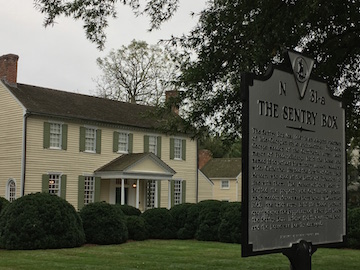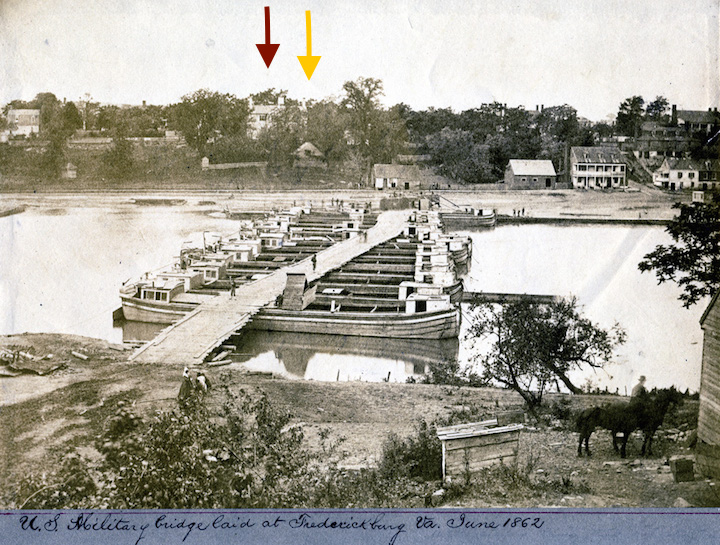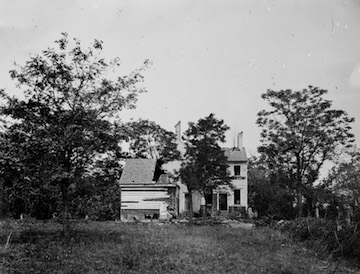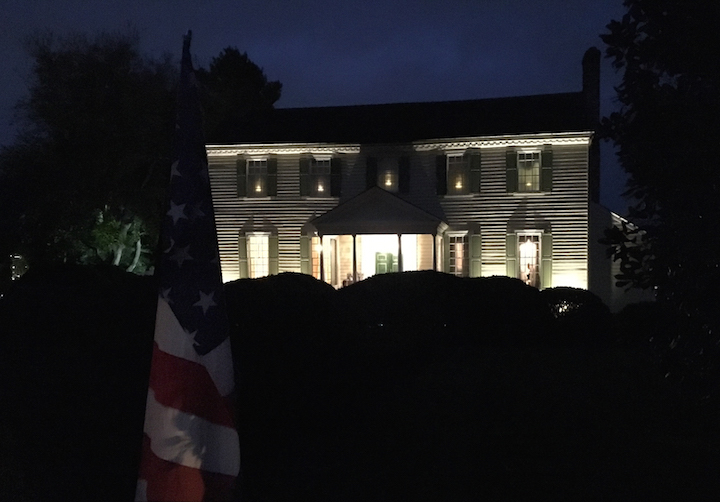Fredericksburg, Virginia’s Sentry Box

Fredericksburg’s Sentry Box has a history spanning several of America’s most tumultuous eras. General George Weedon, a tavern owner, Revolutionary War general, and influential member of the Fredericksburg community, built the house in 1786, calling it the “Sentry Box” in honor of his own experiences in the Continental Army.
The Sentry Box is situated along Caroline Street in lower Fredericksburg, on property General Weedon obtained with Hugh Mercer in 1764. Overlooking the Rappahannock River, the original site was positioned across from Ferry Farm, the childhood home of George Washington. In 1785, Weedon tried unsuccessfully to persuade future president James Monroe to purchase the unfinished house, but later praised the Sentry Box for being “secluded on the Hill and where I call a pleasant place,” revealing his own partiality to the property.
Weedon’s ledger books and personal records from 1786 indicate that he oversaw the Sentry Box’s construction. The finished wood-framed house was two stories high with a large cellar. Built in the Federal style, the Sentry Box has undergone various alterations and additions throughout its 230-year history, reflecting the influences of the Georgian, Greek Revival, and Colonial Revival architecture styles. Several one-story wood-framed buildings stood adjacent to the original house, including a study, a kitchen, a meat house, and an ice house, which would play a role in the Civil War years later.

Weedon moved into the Sentry Box with his wife, Catherine Gordon, in late 1786. Weedon’s sister-in-law and Hugh Mercer’s widow, Isabella Mercer, also moved into the house with the five Mercer children, prompting one of the home’s first expansions. Weedon, having no children of his own, provided generously for his niece and nephews. Upon his death at the Sentry Box in 1793, the property passed into the hands of his wife, Catherine, and subsequently to his nephews John and Hugh Tennent Weedon Mercer, as stipulated by his will.
Though the Sentry Box’s origins dated back to the revolutionary generation, its legacy continued into the Civil War era. Hugh Weedon Mercer, named for his revolutionary grandfather, was born in the Sentry Box in 1808, and eventually became a brigadier general for the Confederacy. Several decades later, in 1859, Charlotte Thornton purchased the house, and not long after, her grandson, Confederate Captain Roy Mason, occupied the Sentry Box with his family.
By late 1862, the Civil War had come to Fredericksburg, marking the first major instance of Civil War combat in an urban center. The Sentry Box provided a backdrop for the fighting that took place in the city’s streets. The house sat just above the middle pontoon bridge the Union Army utilized to cross the Rappahannock in the first opposed river crossing, under fire, in American military history. The Federal soldiers faced constant Confederate fire from the opposite bank, where some of the soldiers were positioned in the Sentry Box’s icehouse, located between the main structure and the river.


After crossing the Rappahannock, Union soldiers occupied lower Fredericksburg on the night of December 11, sacking and looting of many of the homes in the city, including those on Caroline Street. According to the Sentry Box’s current owner, Charles McDaniel, the 17th Mississippi defended the house during the conflict. Local legend held that a friendship between Confederate Captain Roy Mason and Union General Ambrose Burnside prompted efforts to spare the house, although it still sustained significant damage. The Sentry Box survived Federal artillery shelling, but the kitchen was utterly destroyed and had to be rebuilt after the war. Reflecting the battle of Fredericksburg’s reputation for carnage, Roy Mason wrote that following the battle, he found several Federal soldiers who had been killed in and around his home at the Sentry Box, including one deceased officer in his bedchamber.
 Charles McDaniel, a descendant of General George Weedon’s family, purchased the house in 1962. He and his wife have lived in the Sentry Box ever since, and in 1992, the National Park Service added their home to the National Register of Historic Places. A state historical marker stands outside along the sidewalk and the McDaniel’s recently opened their home to the Civil War Trust for a private event. The Sentry Box provides an enduring example of the importance of telling America’s story through the preservation of our historic sites.
Charles McDaniel, a descendant of General George Weedon’s family, purchased the house in 1962. He and his wife have lived in the Sentry Box ever since, and in 1992, the National Park Service added their home to the National Register of Historic Places. A state historical marker stands outside along the sidewalk and the McDaniel’s recently opened their home to the Civil War Trust for a private event. The Sentry Box provides an enduring example of the importance of telling America’s story through the preservation of our historic sites.

thanks chris seen it many times on visits did not know the history ,do love this town
I think you have your Chris/Kris mixed up, Tom!
Thanks Chris. How not to love that town? But what a tortured history! “Kill them! Kill them all!”, said Jackson when asked what to do about the spoliation of the town by Union troops after the battle there in 1862.
I think you’re looking for Kris rather than Chris, John–but glad you liked his piece!
LOL YES I DO STILL LIKED IT THE SAME WAY . SORRY I MISSED YOU IN BUFFALO .OUT OF TOWN
Many years driving down Caroline St while growing up in the area, oblivious to the historical background of this home. Awesome article. Thanks for the research and sharing!
Was interested to find out about this lovely house when researching my family history. Charlotte Thornton purchased the house for her daughter and son-in-law, Captain Roy Mason. The Mason family, from King George County, had a good relationship with General Burnside dating back to time he spent at their home during the wedding of Roy Mason’s older sister to General Dabney Herndon Maury who knew General Burnside from West Point.
Today is Oct 6, 2025 and I, a Weedon by birth, ( in D. C.) am now 91 years old. Is the historic Sentry Box House in Fredericksburg ruined by the flood?